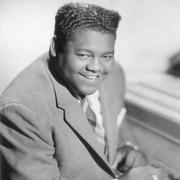Fats Domino
胖子"多米诺,1928年生于美国的新奥尔良,音乐家庭出身,9岁开始学习钢琴,14岁中学退学开始参加演出。 多米诺和小理查德一样,都是南方黑人,都是自弹(钢琴)自唱,音乐背景都是节奏布鲁斯。但是,他的风格显得比较文雅,比较有控制,不太猛烈也不那么耀眼。他的演唱也不像小理查德那么粗声粗气,不带威胁性。他的个人生活更是无可挑剔。 50年代的摇滚乐并不全都是新作品,还有一种做法就是根据旧的波普歌曲按照摇滚乐的风格加以改编,增加摇滚乐的低音声部和明显的摇滚节拍。多米诺在这方面取得了较为突出的成绩。 by Richie UnterbergerThe most popular exponent of the classic New Orleans R&B sound, Fats Domino sold more records than any other black rock & roll star of the 1950s. His relaxed, lolling boogie-woogie piano style and easygoing, warm vocals anchored a long series of national hits from the mid-50s to the early 60s. Through it all, his basic approach rarely changed. He may not have been one of early rocks most charismatic, innovative, or threatening figures, but he was certainly one of its most consistent.Dominos first single, The Fat Man (1949), is one of the dozens of tracks that have been consistently singled out as a candidate for the first rock & roll record. As far as Fats was concerned, he was just playing what hed already been doing in New Orleans for years, and would continue to play and sing in pretty much the same fashion even after his music was dubbed rock & roll.The record made number two on the R&B charts, and sold a million copies. Just as important, it established a vital partnership between Fats and Imperial A&R man Dave Bartholomew. Bartholomew, himself a trumpeter, would produce Dominos big hits, co-writing many of them with Fats. He would also usually employ New Orleans session greats like Alvin Tyler on sax and Earl Palmer on drums — musicians who were vital in establishing New Orleans R&B as a distinct entity, playing on many other local recordings as well (including hits made in New Orleans by Georgia native Little Richard). Domino didnt cross over into the pop charts in a big way until 1955, when Aint That a Shame made the Top Ten. Pat Boones cover of the song stole some of Fats thunder, going all the way to number one (Boone was also bowdlerizing Little Richards early singles for pop hits during this time). Dominos long-range prospects werent damaged, however; between 1955 and 1963, he racked up an astonishing 35 Top 40 singles. Blueberry Hill (1956) was probably his best (and best-remembered) single; Walking to New Orleans, Whole Lotta Loving, Im Walking, Blue Monday, and Im in Love Again were also huge successes.After Fats left Imperial for ABC-Paramount in 1963, he would only enter the Top 40 one more time. The surprise was not that Fats fell out of fashion, but that hed maintained his popularity so long while the essentials of his style remained unchanged. This was during an era, remember, when most of rocks biggest stars had their careers derailed by death or scandal, or were made to soften up their sound for mainstream consumption. Although an active performer in the ensuing decades, his career as an important artist was essentially over in the mid-60s. He did stir up a bit of attention in 1968 when he covered the Beatles Lady Madonna single, which had been an obvious homage to Fats style.


 Please Dont Leave Me - Fats Domino
Please Dont Leave Me - Fats Domino




























![[STATION] aespa《Dreams Come True》MV Teaser - aespa (에스파)](https://img2.kuwo.cn/wmvpic/324/79/54/2120387380.jpg?imageView2/1/w/195/h/130/format/jpg/q/60)





